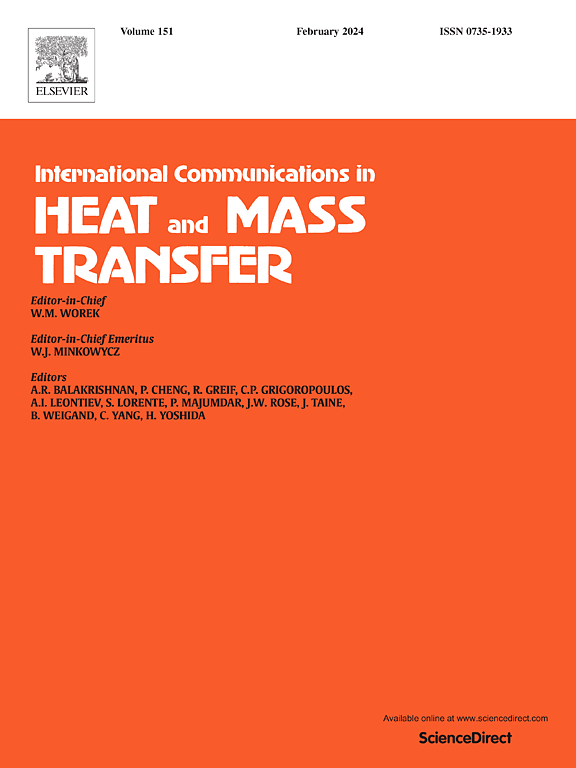相变材料提高太阳能热水器效率:数值评估
IF 6.4
2区 工程技术
Q1 MECHANICS
International Communications in Heat and Mass Transfer
Pub Date : 2025-05-29
DOI:10.1016/j.icheatmasstransfer.2025.109129
引用次数: 0
摘要
太阳能热水器是收集太阳能的有效手段;尽管由于一些原因,包括灰尘、云层和白天没有太阳,它们的功效会随着时间的推移而减弱。因此,有必要采用其他方法来优化系统性能。本文对太阳能热水器的性能进行了数值研究。介绍了一种新型热交换器型太阳能集热器的几何设计。本研究利用计算流体动力学(CFD)分析研究了翅片对太阳能热水器热效率的影响。并对模型的网格划分进行了验证。采用紊流k-ε、RNG模型,利用ANSYS Fluent 2020 R1求解三维模型。研究了三种结构:一个没有鳍的基本模型,一个包括两个鳍的模型和一个包含四个鳍的模型。为了在恶劣条件下提高储热性能,在壳体空间中嵌入相变材料(PCMs)。在正常运行条件下,PCM以潜热的形式储存热能,并在没有太阳的情况下将热能释放回加热流体。由于热导率较低,采用扩展表面来缩短PCM的熔化周期。计算结果表明,采用翅片可以显著提高传热和蓄热效率。结果表明:在450 s时,会议模型、A模型、B模型出水温度分别达到51.4℃、67.4℃、67.5℃;这表明,与标准设计相比,使用两个和四个鳍片的模型的输出水温分别上升了7.1%和7.3%。此外,配备翅片的模型比基本模型更快地达到稳态条件,突出了翅片在加速PCM传热方面的效率。温度分布曲线表明,翅片系统的热入口长度减少,证实了性能的提高。强调了翅片设计和相变材料集成对提高太阳能热水器热管理的意义。建议的设计增强了能量储存,减少了对化石燃料的依赖,支持可持续能源项目,并强调了先进热能技术在可再生能源系统中的重要性。本文章由计算机程序翻译,如有差异,请以英文原文为准。
Enhancing the efficiency of solar water heaters with phase change materials: Numerical assessment
Solar water heaters are an efficient means of collecting solar energy; even though their efficacy diminishes with time owing to several reasons, including dust, cloud cover, and the sun's absence during daylight hours. Therefore, it is essential to employ additional methods to optimize system performance. In this study, the performance of solar water heater numerically investigated. A current geometrical design for a solar collector shaped like a heat exchanger is introduced. This study utilizes computational fluid dynamics (CFD) analysis to examine the effects of fins on the thermal efficiency of a solar water heater. Validation with previous study is conducted and the model meshing are tested. Turbulent k-ε, RNG model were used to solve the 3D model using ANSYS Fluent 2020 R1. Three configurations were examined: a fundamental model devoid of fins, a model including two fins, and a model incorporating four fins. In order to enhance the thermal storage through the clement condition, phase change material (PCMs) was embedded in the shell space. Through the normal operating conditions, PCM storing the thermal energy as a latent heat and release it back to the heating fluid through the absents of the sun. Sins the thermal conductivity is low, extended surfaces are utilized to shorten the melting period of PCM. The calculations indicated that using fins markedly enhances heat transport and storage efficiency. The findings show that the outlet water temperature reaches 51.4, 67.4, 67.5 for the conferential model, model A, model B, at 450 s respectively. Which indicated a 7.1 % and 7.3 % rise in output water temperature for models using two and four fins, respectively, compared to the standard design. Moreover, the fin-equipped models attained steady-state conditions more rapidly than the basic model, highlighting the efficiency of fins in expediting heat transfer through the PCM. The temperature distribution profiles demonstrated reduced thermal entry lengths in finned systems, corroborating improved performance. This study emphasizes the significance of fin design and phase change material integration in enhancing the thermal management of solar water heaters. The suggested design enhances energy storage and diminishes reliance on fossil fuels, supporting sustainable energy programs and highlighting the significance of advanced thermal technologies in renewable energy systems.
求助全文
通过发布文献求助,成功后即可免费获取论文全文。
去求助
来源期刊
CiteScore
11.00
自引率
10.00%
发文量
648
审稿时长
32 days
期刊介绍:
International Communications in Heat and Mass Transfer serves as a world forum for the rapid dissemination of new ideas, new measurement techniques, preliminary findings of ongoing investigations, discussions, and criticisms in the field of heat and mass transfer. Two types of manuscript will be considered for publication: communications (short reports of new work or discussions of work which has already been published) and summaries (abstracts of reports, theses or manuscripts which are too long for publication in full). Together with its companion publication, International Journal of Heat and Mass Transfer, with which it shares the same Board of Editors, this journal is read by research workers and engineers throughout the world.

 求助内容:
求助内容: 应助结果提醒方式:
应助结果提醒方式:


